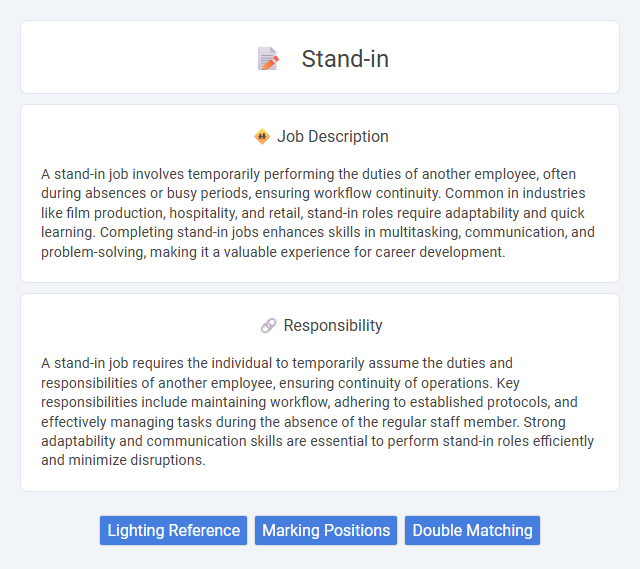
A stand-in job involves temporarily performing the duties of another employee, often during absences or busy periods, ensuring workflow continuity. Common in industries like film production, hospitality, and retail, stand-in roles require adaptability and quick learning. Completing stand-in jobs enhances skills in multitasking, communication, and problem-solving, making it a valuable experience for career development.
Stand-in jobs may be suitable for individuals who are adaptable, quick learners, and comfortable with varying work environments and tasks. People who thrive under uncertainty and have strong interpersonal skills likely find these roles manageable and rewarding. Those who prefer routine, predictability, or long-term consistency might struggle to adjust to the transient nature of stand-in work.
Qualification
Stand-in jobs typically require strong adaptability, excellent communication skills, and the ability to quickly learn new tasks or processes. Candidates often need experience relevant to the specific industry, such as acting for theatrical stand-ins or technical skills for production stand-ins. Certifications or prior training in the field can significantly enhance qualification, demonstrating reliability and professionalism.
Responsibility
A stand-in job requires the individual to temporarily assume the duties and responsibilities of another employee, ensuring continuity of operations. Key responsibilities include maintaining workflow, adhering to established protocols, and effectively managing tasks during the absence of the regular staff member. Strong adaptability and communication skills are essential to perform stand-in roles efficiently and minimize disruptions.
Benefit
Stand-in jobs probably offer flexible working hours, which can help balance personal commitments and increase overall job satisfaction. They may provide opportunities to gain diverse experience and improve adaptability in various work environments. Income from stand-in roles is likely to help bridge financial gaps during employment transitions or periods of reduced regular work.
Challenge
Stand-in jobs may present significant challenges due to their unpredictable nature, requiring quick adaptability and resilience. The likelihood of facing varied work environments and tasks could test an individual's problem-solving skills and flexibility. Navigating these demands might enhance one's ability to perform under pressure and manage uncertainty effectively.
Career Advancement
Stand-in jobs provide valuable on-the-job experience that enhances skills and industry knowledge, serving as a strategic stepping stone for career advancement. These roles offer opportunities to build professional networks and demonstrate reliability, increasing the likelihood of promotions or permanent positions. Employers often view stand-in workers as adaptable and committed, which can accelerate upward mobility within competitive job markets.
Key Terms
Lighting Reference
Stand-in jobs in film and television production involve substituting for principal actors during technical setups, particularly for lighting reference. Stand-ins help lighting technicians adjust illumination levels, angles, and color temperature to ensure consistent and optimal lighting before the main actors appear on set. This process is crucial for maintaining visual continuity and achieving the director's creative vision throughout the shoot.
Marking Positions
Stand-in jobs play a critical role in marking positions during film and theater productions by temporarily filling roles to help set lighting, camera angles, and actor positioning. These professionals ensure continuity and accuracy in scenes, allowing directors and crew to adjust technical elements without the primary actors present. Effective marking aids in smooth transitions and precise shot framing, enhancing overall production quality.
Double Matching
Double matching in stand-in jobs involves pairing both the employer's specific requirements and the stand-in worker's skills to ensure optimal fit. This precise alignment reduces mismatches and enhances job performance, leading to increased satisfaction for both parties. Efficient double matching systems leverage advanced algorithms and data analysis to streamline recruitment and placement processes.
 kuljobs.com
kuljobs.com